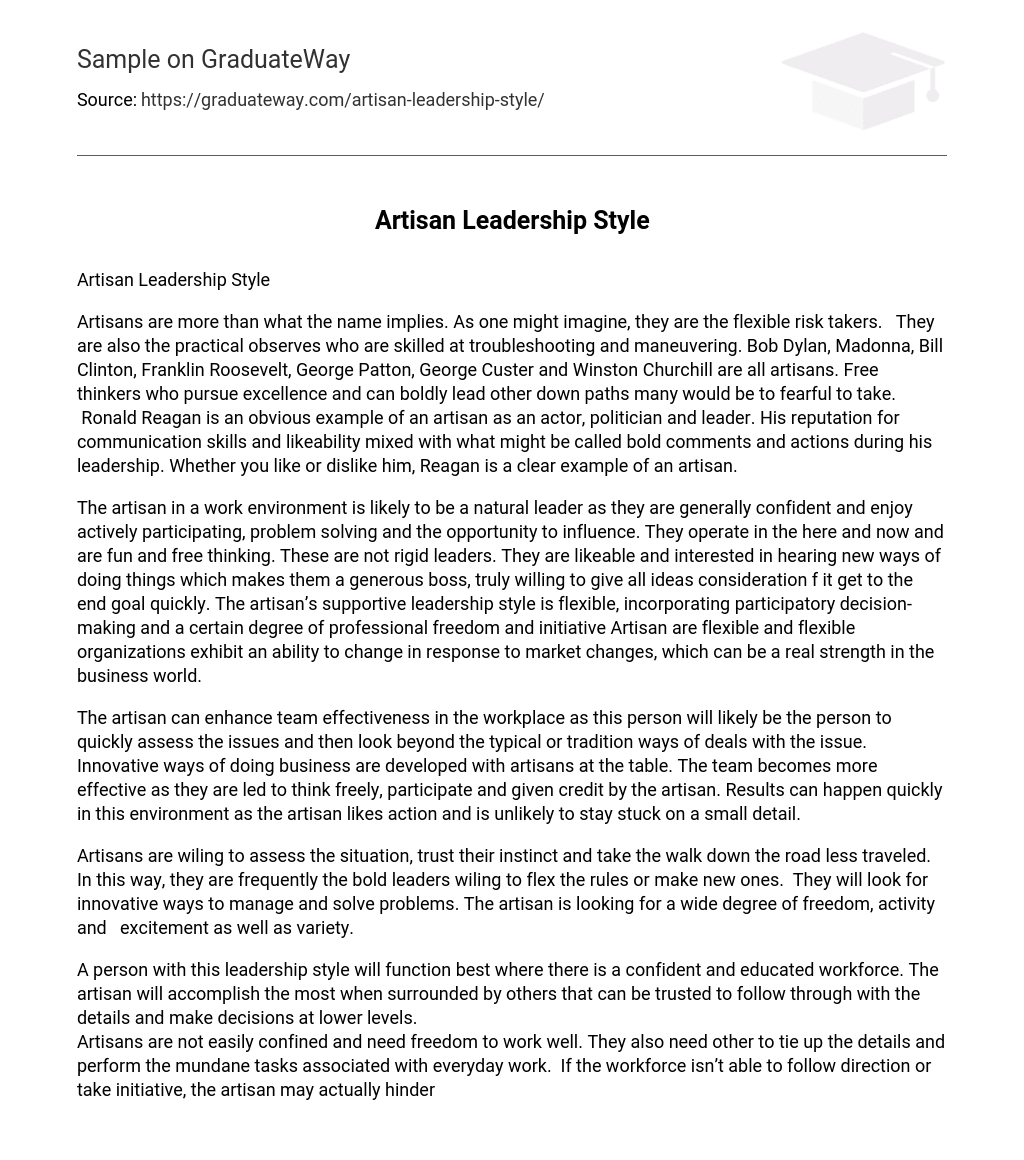Artisans are more than what the name implies. As one might imagine, they are the flexible risk takers. They are also the practical observes who are skilled at troubleshooting and maneuvering. Bob Dylan, Madonna, Bill Clinton, Franklin Roosevelt, George Patton, George Custer and Winston Churchill are all artisans. Free thinkers who pursue excellence and can boldly lead other down paths many would be to fearful to take. Ronald Reagan is an obvious example of an artisan as an actor, politician and leader. His reputation for communication skills and likeability mixed with what might be called bold comments and actions during his leadership. Whether you like or dislike him, Reagan is a clear example of an artisan.
The artisan in a work environment is likely to be a natural leader as they are generally confident and enjoy actively participating, problem solving and the opportunity to influence. They operate in the here and now and are fun and free thinking. These are not rigid leaders. They are likeable and interested in hearing new ways of doing things which makes them a generous boss, truly willing to give all ideas consideration f it get to the end goal quickly. The artisan’s supportive leadership style is flexible, incorporating participatory decision-making and a certain degree of professional freedom and initiative Artisan are flexible and flexible organizations exhibit an ability to change in response to market changes, which can be a real strength in the business world.
The artisan can enhance team effectiveness in the workplace as this person will likely be the person to quickly assess the issues and then look beyond the typical or tradition ways of deals with the issue. Innovative ways of doing business are developed with artisans at the table. The team becomes more effective as they are led to think freely, participate and given credit by the artisan. Results can happen quickly in this environment as the artisan likes action and is unlikely to stay stuck on a small detail.
Artisans are wiling to assess the situation, trust their instinct and take the walk down the road less traveled. In this way, they are frequently the bold leaders wiling to flex the rules or make new ones. They will look for innovative ways to manage and solve problems. The artisan is looking for a wide degree of freedom, activity and excitement as well as variety.
A person with this leadership style will function best where there is a confident and educated workforce. The artisan will accomplish the most when surrounded by others that can be trusted to follow through with the details and make decisions at lower levels.
Artisans are not easily confined and need freedom to work well. They also need other to tie up the details and perform the mundane tasks associated with everyday work. If the workforce isn’t able to follow direction or take initiative, the artisan may actually hinder the environment as they will not stick around to pick up the pieces. Environments with less skilled and confident workers will need a traditional manager in the mix to provide structure and assure employee follow through.
Generally, a well-educated, competent and professional work group desires greater initiative and decision-making power. Such people believe they have a great deal to offer and will feel frustrated if they are expected merely to obey. The leadership or coworker with this style can bring energy and open-mindedness to a work environment.
A less educated and less technically competent group will feel a need for greater authoritarianism and formal structuring. Staff that lacks the confidence and experience may be uncomfortable with the flexibility and need a more directive authoritative approach.
As a staff person, the artisan can prove to be challenge for the person he or she reports to as the artisan is likely to run with an idea. If the supervisor isn’t comfortable with the work style, conflict can occur. The supervisor can feel threatened or disrespected but the artisans speed and resourcefulness to accomplish the goal before the supervisor has fully explained. This is likely to be an issue for those newer employees with a propensity to his style. Artisans may look for employment at firms that embrace the quick paced, freedom to act skills this person can bring. However, the artisan is likely to have trouble conforming to a more rigid environment where there is little opportunity to create or think innovatively.
Artisans have the mix of tactical risk taker with the ability to motivate and move things forward to achieve success. Artisans tend to be leaders rather than managers. It is important for the artisan to choose the right work environment for their style. It is also important for the business to identify artisans and make sure there is a place for them in their environment. Often, these individuals are in leadership positions in politics, business as well as the arts. They may simply not be drawn to a more traditional and authoritative work environment.
As with anything in life, it’s important to know oneself and choose carefully based on that knowledge. Artisans will be suited to organizations where the opportunity to try new thing, work independently and think outside of the box are encouraged.
Sources
Annell, Barbro and Wilson, Timothy, The flexible firm and the flexible coworker
Journal: Journal of Workplace Learning Jun 2000 Volume: 12 Issue: 4
Einstein, Walter O, Leadership and Temperament Congruence: Extending the Expectancy Model of Work Motivation, Journal of Leadership & Organizational Studies
Date: Spring 2004
Overholt, Miles H., Flexible Organizations: Using Organizational Design as Competitive Advantage., Human Resources Planning Vol 20, 1997.
Robinson, Julia, The Role of the Independent Political Leadership Style, Public Administration Review, Vol 58, 1998





